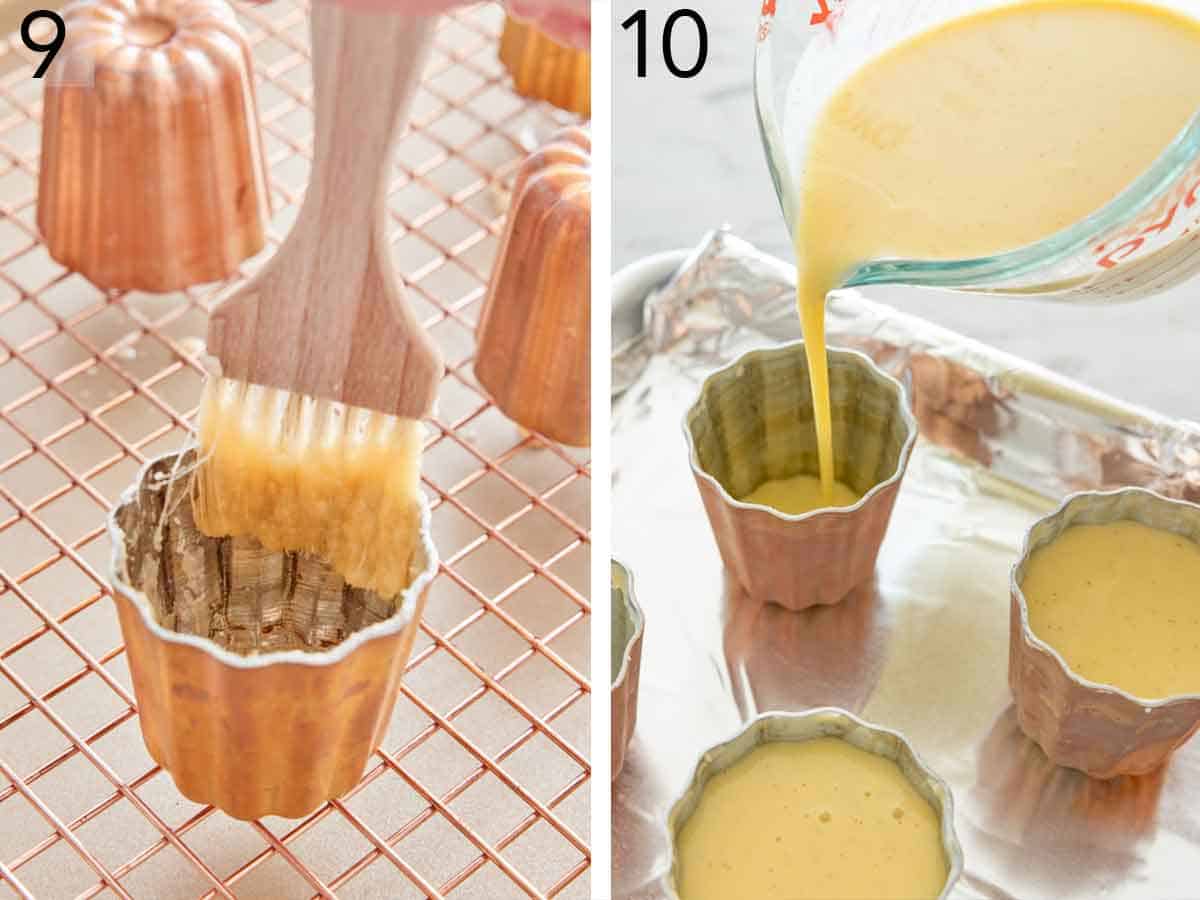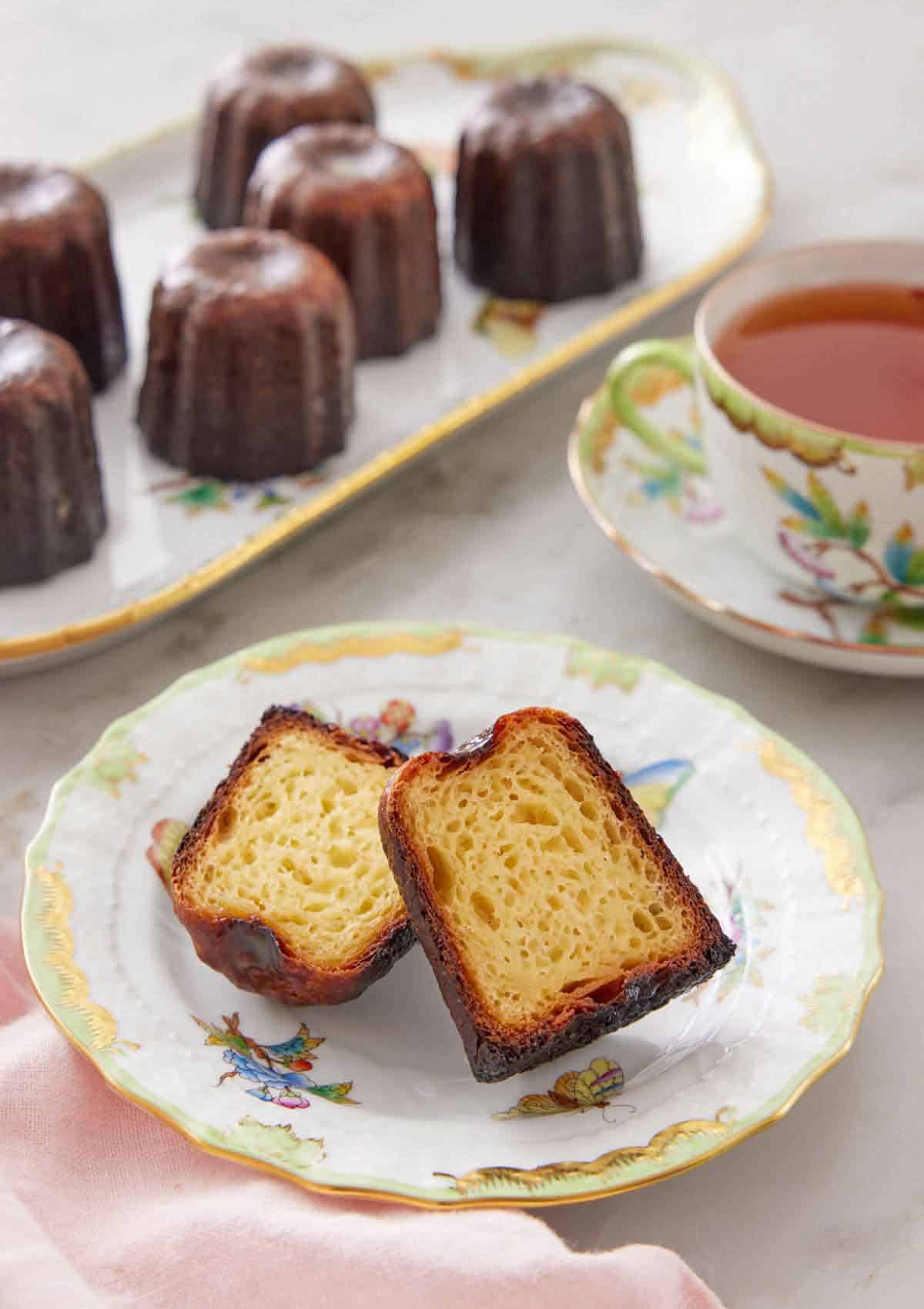You may know these delicious canelés as cannelé, canale, cannelé de Bordelais, or canelé de Bordeaux. They are small individual vanilla and rum flavored French pastries with an irresistibly crispy and caramelized exterior along with a moist and custardy center.
There are many theories as to where the pastry originated but like most recipes, it’s challenging to identify which is the correct theory. The most common theory is that canelés originated from the Couvent des Annonciades in Bordeaux in the 15th or 18th century (hence the name canelé de Bordeaux). Currently, you can find them throughout France and in some pâtisseries abroad.
While I won’t lie to you and say making canelés is easy, I will say they’re worth the effort. They can be challenging to make as they require patience and practice, but the end results are absolutely stunning. Their caramelized exterior makes for such a satisfying experience as you bite into an almost pudding-like custardy interior after breaking through the crispy shell. They are a showstopping pastry that is perfect for special occasions.
If you want another delicious French dessert recipe, then try my macarons recipe, profiterole recipe, or mille-feuille recipe.
What You Need to Make This Recipe

Milk — whole milk is ideal as the canelés benefit from the higher fat content in whole milk to create a wonderfully custardy interior.
Butter — I highly recommend using European-style butter as it has a higher fat content, and again, it helps create a custardy interior.
Eggs — the eggs help with the texture of the canelés, and the extra yolks make them even richer and more flavorful.
Flour — all-purpose flour is best as it provides just enough structure without making the interior cakey or too chewy.
Rum — the rum will bake off in the oven, leaving you with just the rum flavoring.
Beeswax — you will need beeswax to get the classic, beautiful, and shiny exterior of the canelés. Be sure to use food-grade unscented beeswax for the coating.
How to Make Canelés

1. Combine the milk and ¼ cup of sugar in a small pot. Split the vanilla bean and scrape out the seeds. Add both to the pot.
2. Place the small pot over medium-high heat and bring to a simmer, stirring frequently. Add the butter and turn off the heat. Stir until the butter is melted.

3. In a large bowl, whisk together the egg yolks, egg, salt, and remaining ¾ cup of sugar until well combined.
4. Remove the vanilla bean pod from the milk mixture and reserve. Slowly whisk in about half of the hot milk into the egg mixture.

5. Whisk in the flour until well combined, then whisk in the rest of the hot milk.
6. Stir in the rum.

7. Strain the batter through a fine-mesh sieve into a large container. Add the vanilla bean pod to the batter, cover, and refrigerate for at least 24 hours and up to 5 days.
8. Combine the butter and beeswax in a wide-mouth mason jar. Gently melt both together in a pot of water over medium-low heat or in the microwave.

9. Place the molds on a baking sheet and in the oven for a few minutes, just to warm them up. Wearing an oven mitt or glove, hold a canelé mold and brush a thin coating of the beeswax mixture all over the inside of the mold. Place the mold upside down on a wire rack to drain and cool. Repeat with your remaining molds. Once the molds have cooled, place them in the freezer until ready to use or at least 15 minutes.
10. Place up to 6 frozen molds on a small foil-lined baking sheet. Stir the chilled batter together and fill the molds on the baking sheet until they are almost full. Bake for 15 minutes. Reduce the temperature to 400F and continue baking for 45 minutes to 1 hour or until the tops are a dark brown and the canelés have settled back into their molds. Remove from the oven and immediately invert each mold onto a wire cooling rack. Remove the molds and allow the canelés to cool completely. Repeat the baking process with the remaining batter.

Pro Tips for Making This Recipe
- There are several different options for canelé molds, from the traditional copper molds made in France to other more economically priced molds and even muffin pan-style molds. All of them will bake a delicious canelé, but the final results may vary due to slight variations in the molds’ material, thickness, and shape. In testing, I found the French-made molds were somewhat tricky to get started with but gave the best results with the correct coloring and a crisp crust all over the canelés. The less expensive molds had a sunken white top. They still baked through and were delicious, but they did not have that classic look these French pastries are known for. The muffin pan-style molds worked very well but were squattier than the traditional copper molds.
- If using a muffin pan style of molds, I recommend not preheating the molds before coating them in the butter-wax mixture. Instead, lightly brush the coating onto the inside of the molds, then freeze as directed. Fill the molds about ½-inch from the top edge. The bake time may increase or decrease depending on the size of the molds. Just look for a deep golden brown color on the top of the molds.
- You will need to be patient and rest the batter in the fridge for 24 hours, as the texture of the interior of the canelés will not be the same if you bake them right away.
- Do not open the oven to take a look! The high heat at the beginning will ensure a crispy crust on the canelés, and opening the oven door will let all the hot air out.
- If you have a mixing bowl with a spout, I recommend using it to make pouring the batter into the canelés mold much more effortless.
- I highly recommend using a scale to measure your ingredients, as it’s the most accurate method. If you don’t have a scale, fluff your flour with a spoon and sprinkle it into your cups before leveling it off with a knife. This method prevents you from overpacking the measuring cup.
- Eggs are easier to separate when cold. I recommend separating them in advance if you have the time.

Frequently Asked Questions
This is such an important step for using new, single copper molds! To season, fill each mold almost to the top with vegetable oil, leaving about an ⅛” of space. Place on a baking sheet and in the oven. Heat to 300F and bake for 1 hour. Turn the oven off and let the oil and molds cool completely. Empty and wipe the inside and outside of each mold well. Once seasoned, do not clean the molds after use. Simply wipe them down again to remove any excess oil or beeswax coating.
Sometimes the batter in the mold doesn’t sink back in all the way while they bake, leading them to have “white butts” or “white bottoms.” This happens if you overfill your mold. Make sure you leave about ⅜-inch of space between the batter and the top edge of the mold.
I recommend checking the temperature of your oven to ensure it is accurate. If you bake them for too long or if the temperature is too low, they will not have a beautiful airy, spongy interior. The recipe calls for a few different temperatures, so make sure to read through the instructions carefully.
While it’s best to enjoy canelés immediately, you can make the batter five days ahead of time and leave it in the fridge to chill.
Canelés don’t keep too well for long periods, so I recommend enjoying them immediately. However, you can freeze leftover canelés. When ready to enjoy, you can reheat them in the molds for about 5 minutes to make the crust crispy again. Just because you can do it, does not mean you should.
If you’ve tried this Canelés recipe, then don’t forget to rate the recipe and let me know how you got on in the comments below, I love hearing from you!

Canelés
Video
Ingredients
For the Batter:
- 2 cups whole milk (480ml)
- 1 cup granulated sugar (200g)
- 1 vanilla bean
- ¼ cup European-style unsalted butter (57g)
- 3 egg yolks
- 1 large egg
- ¼ teaspoon salt
- 1 cup all-purpose flour (120g)
- ¼ cup dark rum (60ml)
For the Coating:
- ⅓ cup unsalted butter melted (clarified is best) (75g)
- ¼ cup beeswax pellets or grated (see Notes) (40g)
Instructions
For the Batter:
- In a small pot, combine the milk and ¼ cup of sugar. Split the vanilla bean and scrape out the seeds. Add both to the pot. Place over medium-high heat and bring to a simmer, stirring frequently. Add the butter and turn off the heat. Stir until the butter is melted.
- In a large bowl, whisk together the egg yolks, egg, salt, and remaining ¾ cup of sugar until well combined.
- Remove the vanilla bean pod from the milk mixture and reserve. Slowly whisk in about half of the hot milk into the egg mixture. Whisk in the flour until well combined, then whisk in the rest of the hot milk. Stir in the rum.
- Strain the batter through a fine-mesh sieve into a large container. Add the vanilla bean pod to the batter, cover, and refrigerate for at least 24 hours and up to 5 days. (I prefer 48 hours.)
- Make sure your molds are seasoned if they are new. See Notes about the seasoning method.
For the Coating:
- Combine the butter and beeswax in a wide-mouth mason jar. Gently melt both together by placing the jar in a small pot with enough water to come up to the same level as the butter and beeswax in the jar. Heat over medium-low heat. (Do not let the water boil.). Stir the mixture occasionally until melted. Or, microwave the jar in 30-second intervals, stirring between each, until the mixture is melted and combined.
For the Assembly:
- Preheat the oven to 300F.
- Place the molds on a baking sheet and in the oven for a few minutes, just to warm them up. Meanwhile, set a wire rack over a sheet of parchment paper or paper towels.
- Wearing an oven mitt or glove, hold a canelé mold and brush a thin coating of the beeswax mixture all over the inside of the mold. Place the mold upside down on a wire rack to drain and cool. Repeat with your remaining molds. (The coating should be very thin.) Once the molds have cooled, place them in the freezer until ready to use or at least 15 minutes.
- Increase the oven temperature to 500F.
- Once the oven is preheated, place up to 6 frozen molds on a small foil-lined baking sheet. Stir the chilled batter together and fill the molds on the baking sheet until they are almost full. (There should be about ⅜-inch of space left between the batter and the top edge of the mold. I use 80g of batter in my copper molds and 60g in the muffin pan-style molds.) Place the remaining batter back in the fridge.
- Bake for 15 minutes. Reduce the temperature to 400F and continue baking for 45 minutes to 1 hour or until the tops are a dark brown, almost black and the canelés have settled back into their molds. (Depending on how thin the coating is in the molds, some may overflow onto the foil and slightly smoke during baking. This will not affect the canelés bake or flavor, but be ready to turn on your vent hood or open a window.)
- Remove from the oven and immediately invert each mold onto a wire cooling rack. Remove the molds and allow the canelés to cool completely. Repeat the baking process with the remaining batter. The batter can be chilled for up to an additional 48 hours, so the canalés can be baked over time. Canalés should be enjoyed the day they are baked.
Notes
- Be sure to use food-grade unscented beeswax for the coating.
- There are several different options for canelé molds, from the traditional copper molds made in France to other more economically priced molds and even muffin pan-style molds. All of them will bake a delicious canelé, but the final results may vary due to slight variations in the molds’ material, thickness, and shape. In testing, I found the French-made molds were somewhat tricky to get started with but gave the best results with the correct coloring and a crisp crust all over the canelés. The less expensive molds had a sunken white top. They still baked through and were delicious, but they did not have that classic look these French pastries are known for. The muffin pan-style molds worked very well but were squattier than the traditional copper molds.
- If using a muffin pan style of molds, I recommend not preheating the molds before coating them in the butter-wax mixture. Instead, lightly brush the coating onto the inside of the molds, then freeze as directed. Fill the molds about ½-inch from the top edge. The bake time may increase or decrease depending on the size of the molds. Just look for a deep golden brown color on the top of the molds.
- You will need to be patient and rest the batter in the fridge for 24 hours, as the texture of the interior of the canelés will not be the same if you bake them right away.
- Do not open the oven to take a look! The high heat at the beginning will ensure a crispy crust, and opening the oven door will let all the hot air out.
- If you have a mixing bowl with a spout, I recommend using it to make pouring the batter into the mold much more effortless.
- I highly recommend using a scale to measure your ingredients, as it’s the most accurate method. If you don’t have a scale, fluff your flour with a spoon and spoon it into your cups before leveling it off with a knife. This method prevents you from overpacking the measuring cup.
- Eggs are easier to separate when cold. I recommend separating them in advance if you have the time.















Jana Lee says
I have excess ghee/beeswax mixture. Can it be saved for next time and remelted?
Sarah Ward (Executive Editor, Preppy Kitchen) says
Yes! Store it in a jar in the fridge. When you’re ready to use it again, bring it back to room temp and remelt it by placing the jar in a pot of hot water. I would only keep it for a month or two as the butter can start to taste old with time.
Carol says
Used this for my first try at Caneles – loved it. Your recipe made this mysterious recipe so easy to follow. They came out so tasty and crunchy! Thank you!
Donna A Pollock says
These are just lovely.. I want to try to make these, and I will. My son has an appointment at the Coast and he is taking the dogs with him so I can have a break. I’m going to cook as much as I can while he’s gone. The dogs are so spoiled they drive me nuts sometimes. I need to have quiet to do this, but I’m going to do it…Thank you John for these Beautiful French Recipes. They are a must try for me…
Mchilk says
One of the most complete directions and tips that I’ve come upon. I’ve been baking these for years and appreciate the tips and concise directions. Bravo!
Danielle Soldati says
Dearest Chef John,
Your recipes are HEAVEN ON EARTH!…
You have been helping me in the kitchen way more that you could have ever imagine, wow… I love how clear and easy to understand your methodology is, and how detailed you are.
I have a beautiful restaurant in Long Beach, CA, and because of YOU, guests rave with excitement every time we serve our delicious mushroom soup… Actually ANY of my soups! Why? Because you taught me to caramelize the onions for 45 minutes for that depth of flavor! Game changer!…
And now the canelés… I can’t wait to bake them and I know with your golden tips I’ll master them!
I have not enough words to thank you!…
Big hugs filled with gratitude,
Dani Soldati
Ubuntu Café
Mandy says
I am soooo glad you posted this. I bought canelés moulds in Paris last year and have been looking for a good tutorial. Question: once I have made my 6 canelés using my copper tins, do I have to repeat the process of coating them in butter and wax again before the next batch? Thank you for your help!!